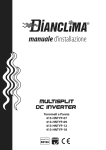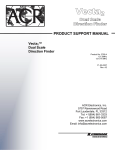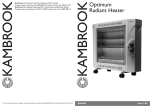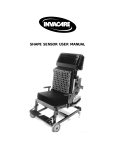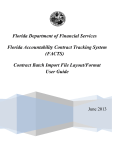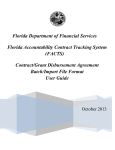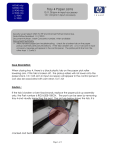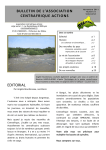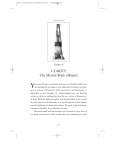Download promotional PDF - Good Old Boat Magazine
Transcript
The sailing magazine for the rest of us! www.goodoldboat.com TM Issue 105 November/December 2015 12 $800 (Canada $800CDN) 12 0 62825 97035 7 TM CONTENTS 38 For the love of sailboats Feature boat 10Mug Up, a 46-foot Bowman yawl A fine example of English lines and lineage BY GARY MILLER Boat comparison 14The Bowman 46 . . . Review boat 61MacGregor 26D Sailboats 101 Spotlight on . . . Sail loft 18Sail-repair essentials Don’t let wear and tear stymie your cruising plans Electronic wizardry 36Anchor windlass remote Marital harmony restored at a bargain non-marine price BY LESLIE LINKKILA AND PHILIP DINUOVO 26Rollaway square sail Downwind sailing with a new-tech nuance BY DARREN BOS BY ROGER HUGHES Seamanship skills 38The ship’s log A daily duty records a lifetime of memories BY ED ZACKO Fun and utility in a lightweight package BY TOM WELLS Speaking seriously BY DON LAUNER . . . and partners from the era of split rigs BY ROB MAZZA 56 16Mainsail Reefing 101 Variations on taking in a slab of sail NOVEMBER/DECEMBER 2015 ISSUE 105 32 Taming a hanked-on headsail A downhaul is a singlehander’s foredeck crew BY CLIFF MOORE Making your own 44When a rudder needs replacing Outsourcing and insourcing assure the best results BY DIANE SELKIRK AND EVAN GATEHOUSE Making it pay 56Sailing for love and money A lifelong sailor supports her passion by chartering BY JOY SHERMAN 10 www.audioseastories.com 18 November/December 2015 Good Old Boat 1 TM CONTENTS ISSUE 105 NOVEMBER/DECEMBER 2015 Just for fun 8 Cruising memories 50Loving Scarlett Life lessons from an early affair BY DON DAVIES ILLUSTRATION BY KATERINA DAVIES Creative alternatives 58Battery à la carte What’s more Cooking up volts in the galley 71Good old classifieds 5 Web sightings New T-shirts with attitude, spit-and-polish tips, back-issue backups, and audio thrills BY CONRAD COOPER The view from here 7 Sailing with ice Lettuce and cold drinks — the frosting on the cruising cake. Reflections 77A eulogy to Johnson A loyal, uncomplaining member of the crew BY ALAN KEENE BY KAREN LARSON Mail buoy and the Stone Horse Derby Simple solutions 8 Classified insanity, parrel balls, 66 On the cover . . . When Paul Rezendes captured this photo of Mug Up, a Bowman 46 yawl, in Cookie Bite Cove on Bartlett Island on the coast of Maine, he caused a whole series of events that resulted in a feature article by Gary Miller about Mug Up and her owner, Mark Lacey. See page 10. www.audioseastories.com 66A portable vise Turn any flat surface into a workbench BY CLIFF MOORE Quick and easy 67Dinghy doormat Trap dirt and sand before they get on the mother ship 58 BY CLIFF MOORE 68A see-through hatchboard Let there be light, even in the cold and wet BY HENK GRASMEYER November/December 2015 Good Old Boat 3 Seamanship skills The Ship’s Log A daily duty records a lifetime of memories I am sitting in front of the fire doing research for an upcoming ocean passage. I like to study the passages of others. What routes did they take? Which months? Did they make good choices and, more important, did their planning result in a good passage? I am lost in this book . . . fascinated. I have made this passage several times, but the account I am reading bears little resemblance to what I remember. Yet it is our very own log of Entr’acte from 2005, our passage from Gibraltar to the Azores. It is our boat, our book, our writing, but these words seem to have been written by someone else. Seemingly innocuous entries trigger the memory. The blanks fill in and the past comes alive as the scenes become once again familiar. I look up to the bookshelf and smile. Entr’acte’s log, which began on her launch date April 1, 1980, and has continued uninterrupted to the present day, now fills 37 beautifully bound volumes. At first glance, these books seem to be a useless compilation by someone with an obsessive/compulsive disorder, or perhaps simply the affectation of a romantic. We were in our mid-20s when we began the Log of Entr’acte and we joked that these journals would be fun to read by the fire when we “got old.” Well, we’re approaching 70 now and we, along with Entr’acte, are still under way. I pause to think about logs. What are they really? What treasures do they hold? What should a log contain? Are they really necessary? BY ED ZACKO Modest beginnings The log from our first 18-foot catboat, Drummer Buoy, was a simple all-in-one book, each page an identical form with columns for every Thirty-something years of cruising fills a yard or so of bookshelf in Ed and Ellen’s pied-a-terre in Arizona, at top. Entr’acte’s ship’s log is a simple 10½ x 8, hard-bound, lined office journal. Ed and Ellen buy several at a time to ensure uniformity and make certain they do not run short. Their inside pages, at right, are filled with details of every day that passed on board. 38 Good Old Boat November/December 2015www.goodoldboat.com Each volume’s cover page is a work of art depicting the destinations covered in that particular book. conceivable phase of boat operation, maintenance, and navigation. Just fill in the blanks as you sail on. Included in this book was a guest log, basic piloting instructions, a Beaufort Scale to judge the wind, barometer instructions for predicting weather, and hurricane survival . . . advice, presumably, for when we failed to predict the weather properly. Our entries, when we made them, were simple and to the point but lacking in narrative. But Drummer Buoy was a very simple boat and our cruising in her was simple. Thanks to Drummer Buoy, and inspired by the writings of Lin and Larry Pardey, the cruising bug bit hard. We built Entr’acte in our backyard, quit our jobs and, with very little money, set out to see the world in complete charge of our boat and our destiny. A Nor’Sea 27, Entr’acte may have been a more sophisticated boat, and our goals were certainly more ambitious, but we still did not take log-keeping seriously. I select volume one and open to 10 August 1981, departure day when we set out from Haverstraw, New York, to see the world: 0700 — “Left right on time!” We have laughed a lot about that entry over the years. Just what were we on time for and why was it so important to leave “on time?” One week and a hundred miles east on Long Island Sound, we made our next entry. In our defense, we were excited, completely exhausted from our preparations, and very familiar with Long Island Sound. Still, in retrospect, the lack of log-keeping was irresponsible. Our first serious offshore passage from Block Island to Chesapeake Bay was chastening. Being a bit cavalier with our navigational entries, we mistook a lighted drilling ship for the New York City skyline and wasted hours in frustration and confusion. These were the salad days before GPS and all navigation was a combination of coastal piloting and celestial navigation using the sun, moon, stars, and planets. We learned in dramatic fashion the absolute necessity of maintaining a good, written DR (dead reckoning). As we traveled farther, we met the serious cruisers, those “long-timers” with tens of thousands of miles under their keels. We were “the kids” who clearly needed some help and we absorbed all the advice that was offered. Foremost of their suggestions was the obligation to “keep a proper log.” Inspecting the logs of these pros was impressive, not only for their regularity but for the detail. Hal Roth’s entries were those of a military vessel and the rest of the book a veritable time capsule. I select volume three and begin a delightful walk through Entr’acte’s history and our life with her. I open to a random page www.audioseastories.com November/December 2015 Good Old Boat 39 Seamanship skills | The ship's log Entr’acte’s log pages are filled with postcards, stamps, local currency, receipts from restaurants with prices, quotes from friends along the way, and any other information Ed and Ellen deem of interest and might wish to remember for future reference. and am reminded what it was like to cruise on a shoestring: a “night on the town” in Spain when we split one beer and one tapa (60 cents) between us. We stretched it out for three hours before drinking up and going home. The entry also mentioned how happy we were. In another volume, we are suddenly in Tonga playing with The Hausia Brothers Band before the King of Tonga. I move to another that details a particularly vile night beating up the coast of Panama and still another that, in one short paragraph, has captured the absolute wonder of our first celestial island landfall: “Perhaps this was not wasted energy after all!” As we sailed on, we gradually matured into responsible sailors and our log evolved as well. It bears little resemblance to that all-in-one book from Drummer Buoy. Logs for everything Entr’acte’s log now comprises three separate books. The primary volume is the actual ship’s log. The second book is a dedicated engine log. The third is a maintenance log. At first, all of the information was in one book, but it proved far too difficult to find critical information when we needed it. Two years into our voyage, we met with a container ship officer and discovered the benefits of separate, dedicated logs. Now, finding critical information is a snap. Without fail, we make a log entry every single day that we are on board. Each entry represents a day in the life of Entr’acte. The morning entry begins with a weather synopsis, harbor conditions, and overnight events. The next entry usually outlines the plan for the day on board or ashore. The evening entry is made just before bedtime and summarizes the day on board as well as significant activities ashore such as social events, concerts, and sightseeing. If an official comes on board, we always request that he sign the log noting the date and time. This book also serves as our journal to record thoughts and impressions on where we are, how we got there, what we did that day, and locals we met and their contact information. The summary written at the end of every passage is extremely useful, even years later, for planning future passages. 40 Good Old Boat November/December 2015www.goodoldboat.com It is so much fun to read about passages made in the past. Several pages are reserved at the back of the book for “significant postings.” These could be theater tickets, bus or train schedules, program cover pages, restaurant receipts, menus, marina bills, and almost anything worthy of future reference, memories, or proof of payment. Passage entries When under way, our navigation entries are regular and complete. For weather, we list barometer reading, sky, cloud cover, wind direction and speed, and sea state and direction. Navigation information includes position, destination, true course, speed, distance to next waypoint and distance to destination, sail combination, rpm if under power, hours accumulated while under power, estimated fuel consumption, and estimated hours of fuel remaining. We keep proper watches and make log entries during the watch. These entries begin with our current position at the start of the watch and include true course, course to steer, barometer reading, weather, wind strength and direction, sea state and direction, and taffrail log reading. Headsail changes and reefing changes are also noted, as are sightings of ships, whales, or anything else of interest. Our DR is constantly maintained, updated, and plotted on a paper chart. Every significant course change is logged and plotted along with the time of change. Despite the use of GPS, experience has taught us that electronics fail suddenly and without warning at very inopportune times, so it is vital to have written down the compass course you are trying to steer. We note changes in wind speed and direction as well as sea state and direction. If we take in or shake out a reef, we note it in the log along with the time. At the conclusion of each watch, the watchkeeper writes a summary of the watch along with specific instructions for the new watch, such as cautions pertaining to events past and instructions for resolving present events like ships on the horizon or impending landfall. Verbal instructions are not remembered well by the new watch coming out of a sound sleep; written instructions are best. Once the anchor is down and secure, we note the exact position along with bottom conditions and a brief description of the effectiveness of the anchorage in case we choose to visit it again someday. At the conclusion of each passage we write a passage summary. What went well? What went wrong? Did our tactics work? What percentage of time did the wind blow from each direction and what point(s) of sail were we on? What percentage of the time was under power? How much fuel was used? How much remains? Which sail combinations did we use and which were most/least effective? What would we do differently? Anything of significance is noted while it is still fresh in our minds. www.audioseastories.com With the above data, we can reconstruct the entire passage, either while under way or years later. These pages have proven extremely valuable in planning future passages. The engine log The engine log is dedicated solely to the maintenance and operation of the engine. This has been the subject of goodnatured ribbing over the years. (“You keep an engine log?”) Yes, we have a small hardbound journal that documents the engine from its initial installation in 1994 to the present day. The inside front cover shows the engine’s make, model, and serial number along with the date and place of installation; the transmission brand, serial number, and gear ratio; the shaft size; propeller size (diameter and pitch) and brand; and the size and part number of the Cutless bearing. The inside back cover lists various settings: valve clearance, torque settings and notes, specifications, and pages of the service manual most commonly referred to. The final pages list commonly replaced parts by name along with their catalog number. These include fuel filter, oil filter, water-pump impeller, belts (brand, size, and number), thermostat, and so on. This format minimizes a lot of digging through the manuals when it’s time to do maintenance. The body of the engine log details actual engine events. Every part installation, belt change, and repair is documented by date and hour-meter reading, and every part number with place of purchase, address, phone number, and cost. Fuel is logged according to engine hours with hourly consumption noted and compared to past runs. Likewise with oil: the weight and brand are noted and consumption or lack thereof is compared to previous runs. We log how much battery water was added and how many hours elapsed between battery top-ups. If any of the above figures show a marked change, that’s a reason to look into things to avoid surprises. November/December 2015 Good Old Boat 41 Seamanship skills | The ship's log Thanks to these records, we know exactly how much fuel we use at various rpm settings and conditions. We can accurately gauge our consumption throughout a passage, reducing the chance of running out of fuel before we arrive in port. Maintenance log This book is a simple tabbed journal. Each section is dedicated to various items on board: watermaker and survival watermaker, galley, rig, dinghy and outboard, sails, winches and deck gear, charts (which are on board and which are needed), computer, life raft, and ditch bag. The maintenance log holds a record of repairs due to breakdown and also documents dates of preventive maintenance. An irreplaceable reference Nostalgia aside, there are other less obvious uses for a log. Research Perhaps you wish to repeat a passage or return to a harbor you visited some years ago. Before departing for Europe in 2003, we read our log from the 1983 passage, which helped us correct our past blunders and have a much better trip. We knew exactly where we were going and who we wanted to see when we arrived. Where was the Bermuda Customs office? It is in many ways like having our own personal cruising guide. Memory is inaccurate. Promises made at sea are soon forgotten in harbor. Many times we spoke of a passage where “nothing happened,” yet after reading the log of that passage we were surprised to find that it was not quite as uneventful as we remembered it. Buying or selling a boat When buying or selling a boat, a set of detailed logs will invariably be an asset. I would want to inspect the logs of 42 Good Old Boat The engine log’s inside cover is a trove of data . . . previous owners, especially the maintenance logs. Here you will discover how and where the boat was used and how she handled and performed under various conditions. Detailed accounts of her passages show how the vessel was sailed and treated. By reading the comments in the log you gain important insight into the actual performance characteristics of a vessel. Were her miles easy or hard? The maintenance logs speak for themselves. No log, no proof, and possibly no maintenance. Legal The ship’s log provides legal documentation of events. A U.S. Customs officer tried to charge us import duty on a new engine that was installed in a foreign country. The burden of proof was on us and our engine log saved the day. Fiji Customs actively prosecutes boats that anchor in Fijian waters before officially clearing into the country. The day we arrived, three boats were fined and our officer was out for blood. “Did you stop and anchor anywhere along the way before you arrived here?” I presented our logbook. He looked at it carefully, smiled, and said, “Thank you.” A yacht collided with a tugboat and several people were killed. The port officials decided that our friends had caused this collision, but their detailed log proved that they were hundreds of miles away from that location at the time the incident occurred. A yacht is allowed to stay in Europe duty-free for a maximum of 18 months. Sail over to Morocco and return to Europe and you get a new 18 months. Likewise, if the crew are in Spain for more than 183 days, they become liable for income tax. With Europe being by and large a free-travel zone, passport stamps into and out of each country have become a thing of the past, so your log might well be the only proof that you did not overstay your time. Passports and clearance papers are sometimes not enough. As one official cautioned us, “Sometimes you can never have enough proof.” Will your log actually be believed? The more regular, consistent, detailed, and professional your entries, the more likely it is your log will be accepted. November/December 2015www.goodoldboat.com rode? The list seems endless. With hundreds of things to maintain, how does one keep track? Time passes swiftly, and the timing of events and routines gradually blends together. Without a written record, these small but vital jobs can be neglected. Treasured memories Thanks to our logs, all of our adventures are documented. Now, as we approach the golden years and can manage a little time to sit by the fire, we read the stories to each other. We are reminded of the wind in the sails, the landfalls, and the excitement of arriving in a new port and meeting locals who became dear, lifelong friends. These volumes are real books, not a virtual computer or tablet file. We tried to keep an electronic log, but as we made the . . . and the inside pages detail every maintenance task performed and the date. same entries, they seemed to disappear. No, we prefer books we can see, touch, feel, and Our anchor windlass is an example. The aluminum smell . . . complete with the occasional old saltwater stains. warping drum is mounted onto a steel shaft. Dissimilar Or might they possibly be tears? Our logs remind us of what metals combined with endless saltwater dunking present cruising should be. Each page is a day in the life of Entr’acte. a real danger that the drum could become permanently If you maintain a log for your good old boat, it will be a corroded to the shaft. With the drum seized to the shaft, treasure. I would be unable to dismantle the windlass for repair Ed Zackois a Good Old Boat contributing editor. He and and it would become a total loss. After a few close calls, Ellen met while playing in the orchestra of a Broadway I concluded that to take 10 minutes each year to remove, musical. They built their Nor’Sea 27, Entr’acte, from a bare grease, and remount the drum is good insurance. It helps to hull and since 1980 have made four transatlantic and one be reminded to do it. transpacific crossing. Entr’acte is now based in Seville, The same goes for aluminum cleats fastened to the mast Spain, where Ellen and Ed are happily sailing in and with stainless-steel machine screws. These screws should be around the Mediterranean and playing in the jazz clubs of removed and re-installed periodically to prevent them from Spain, France, and Morocco. When not on board Entr’acte, becoming permanently welded to whatever they touch. they heave-to in Phoenix, Arizona, where they maintain a When was the emergency watermaker last serviced? busy concert schedule throughout the Southwest U.S. Follow What is the expiration date on the flares? When did we last them on www.enezacko.com. fill the tank for our cooking fuel or end-for-end the anchor www.audioseastories.com November/December 2015 Good Old Boat 43









